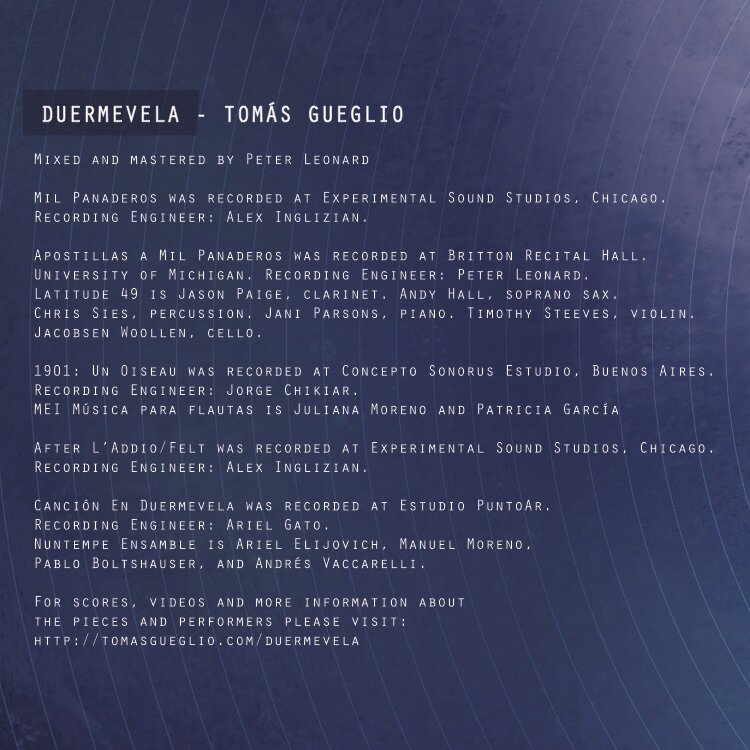“A very precisely layered effort where tone, timbre and technique are all tweaked, manipulated and illuminated in Gueglio’s inimitable vision, you’ve probably never heard a chamber record quite like this one”
“Recordings from New Focus are coming across these days as uniformly excellent and stimulating; this one is no exception. Tomás Gueglio has a fine, individual voice and is fervently championed by the musicians here”
In Spanish, the word ‘Duermevela’ is a combination of two other words: ‘dormir’ (sleep) and ‘velar’ (to stay awake). The album is a collection of five chamber works written between 2013 and 2017. It features recordings by some of my longest standing collaborators and friends from both of my hometowns, Buenos Aires and Chicago.
The album opens with Austin Wulliman performing Mil Panaderos, a work for solo violin originally composed in 2013 and later revised for the recording. Scalar passages, fast arpeggios, and explosive jétés are the motivic fabric of a rhetoric that pendulates between virtuosity and disorientation (the image of Pierrot comes to mind). Mil Panaderos in turn, serves as the basis for Apostillas a Mil Panaderos (‘Apostilla’ meaning ‘addendum’ or ‘note on the margins’ in Spanish) a sextet for soprano sax, clarinet, percussion, piano, violin, and cello, written for Latitude 49.
In the process of transcription from solo to sextet, the character of the work changed substantially. What in the original was virtuosity and bravura, became in the sextet version intimacy and introspection. In the words of Timothy Steeves (Latitude 49’s violinist) “the texture of the piece is sparse […] Each sonic event therefore becomes an invaluable addition of color and sonority”.
1901: Un Oiseau is a two-movement piece for two bass flutes dedicated to Argentine duo MEI Música para flautas. At the onset, both flutes display almost identical pitch material set to slightly different rhythms. This resulting heterophony is then orchestrated through a kaleidoscopic array of sounds that include sighing, whistling and singing. These two initially very similar streams progressively diverge, carving more individual paths towards a brief contemplative drone that eventually ushers a playful coda.
Also in two movements is After L'Addio / Felt for solo harp, composed in collaboration with Ben Melsky. The piece’s two contrasting tableaux each explore a specific harp technique. The first movement focuses on the idea of glissando, finding different sounds by varying the degree of pressure between hands and strings and by performing with different parts of the hand (knuckle, nail, fingertips, palm…). The second movement focuses on the performance of harmonics. By employing this technique on different parts of the string (and on different strings) the resulting texture is a somewhat unpredictable mix of regular harmonics, percussive thuds and rich and complex multiphonics.
The last piece in the album is Canción en Duermevela, a guitar quartet composed for Nuntempe Ensamble. The four movements of the work are connected through a melody (a kind of cantus firmus) that is distributed between the four players, consistently harmonized as chromatic clusters, and surrounded by an assortment of sounds, some common some less so. The resulting texture ascends in pitch, progressively giving way to longer and longer solos eventually reaching a suspended, landscape-type ending.



